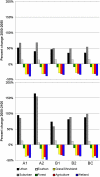National housing and impervious surface scenarios for integrated climate impact assessments
- PMID: 21078956
- PMCID: PMC3000269
- DOI: 10.1073/pnas.1002096107
National housing and impervious surface scenarios for integrated climate impact assessments
Abstract
Understanding the impacts of climate change on people and the environment requires an understanding of the dynamics of both climate and land use/land cover changes. A range of future climate scenarios is available for the conterminous United States that have been developed based on widely used international greenhouse gas emissions storylines. Climate scenarios derived from these emissions storylines have not been matched with logically consistent land use/cover maps for the United States. This gap is a critical barrier to conducting effective integrated assessments. This study develops novel national scenarios of housing density and impervious surface cover that are logically consistent with emissions storylines. Analysis of these scenarios suggests that combinations of climate and land use/cover can be important in determining environmental conditions regulated under the Clean Air and Clean Water Acts. We found significant differences in patterns of habitat loss and the distribution of potentially impaired watersheds among scenarios, indicating that compact development patterns can reduce habitat loss and the number of impaired watersheds. These scenarios are also associated with lower global greenhouse gas emissions and, consequently, the potential to reduce both the drivers of anthropogenic climate change and the impacts of changing conditions. The residential housing and impervious surface datasets provide a substantial first step toward comprehensive national land use/land cover scenarios, which have broad applicability for integrated assessments as these data and tools are publicly available.
Conflict of interest statement
The authors declare no conflict of interest.
Figures




References
-
- Ellis EC, Ramankutty N. Putting people in the map: antropogenic biomes of the world. Front Ecol Environ. 2008;6:439–447.
-
- Brown DG, Johnson KM, Loveland TR, Theobald DM. Rural land-use trends in the conterminous United States, 1950–2000. Ecol Appl. 2005;15:1851–1863.
-
- Johnston R, Gao S, Clay M. Modeling long-range transportation and land use scenarios for the Sacramento Region using citizen-generated policies. Transp Res Record. 2005;1902:99–106.
-
- Theobald DM. Landscape patterns of exurban growth in the USA from 1980 to 2020. Ecol Soc. 2005;10:32.
-
- IPCC. Climate Change 2001: The Scientific Basis. Contribution of Working Group I to the Third Assessment Report of the Intergovernmental Panel on Climate Change. Cambridge, UK: Cambridge University Press; 2001. p. 881.
Publication types
MeSH terms
Substances
LinkOut - more resources
Full Text Sources
Medical
Molecular Biology Databases
Miscellaneous

